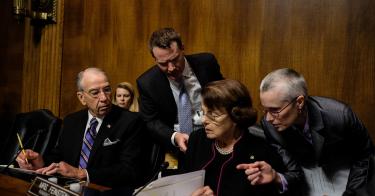During the 115th Congress, the Democrats’ approach to the judicial confirmation process can be summed up as “Do as I say now, not as I did then.” And they’ve given no hint of changing that strategy when they come back after the midterm election.
Last year, for example, Democrats complained about including more than one nominee to the U.S. Court of Appeals in a single confirmation hearing. They hoped no one would remember that previous chairmen, of both parties, have held more than 50 hearings with multiple appeals-court nominees. Senator Dianne Feinstein (D., Calif.) served on the Judiciary Committee in the 1990s when Chairman Orrin Hatch (R., Utah) held a dozen such hearings for President Bill Clinton’s nominees. I haven’t found any Feinstein objection to doing for Democratic nominees what she now opposes for Republican nominees.
When the Senate resumes its work on November 13, look for Democrats to re-double their efforts to prevent filling the many longstanding vacancies across the federal judiciary.
Today, 14 percent of the judiciary’s seats are vacant. In fact, we are in the longest period of triple-digit judicial vacancies in 25 years. This is in spite of President Trump making nearly 40 percent more nominations, and the Judiciary Committee holding hearings for 32 percent more nominees, than under previous new presidents at this point. In November of those presidents’ second year in office, judicial vacancies averaged less than 8 percent.
Precedent is a funny thing. In the Senate, past practice is worth following until it isn’t. Nonetheless, here’s what the judicial confirmation process has looked like during previous lame-duck sessions following midterm elections.
Democrats controlled the entire appointment process — nomination and confirmation — in the last two midterm elections. In 2014, Democrats confirmed 27 nominees to the federal district courts after Election Day. Don’t think that these were all low-hanging confirmation fruit, either. President Obama’s two most controversial district-court appointees were confirmed, with 45 and 46 negative votes, in this batch.
In 2010, the Judiciary Committee held a confirmation hearing in November, and the Senate continued confirming judicial nominees until December 22. The 19 judges confirmed in December included five to the U.S. Court of Appeals and two more highly controversial nominees to the U.S. District Court.
Overall, the Senate has met after a midterm election ten times since the Second World War and confirmed judges in nine of those lame-duck sessions. In the two most recent, Democrats confirmed nearly as many judges as in the rest combined.
Nearly three dozen nominees to the district and appeals courts are ready for confirmation now. Whether it’s the needs of the judicial branch, past confirmation practice, or both, the Senate should get to work as soon as they return.
This piece originally appeared in the National Review




